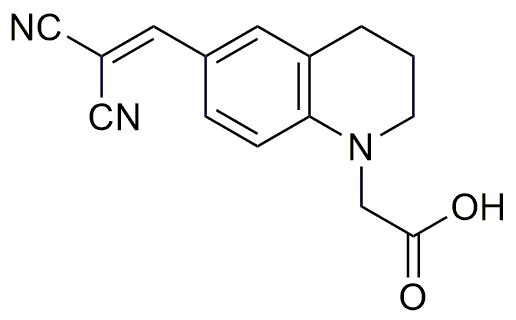N-Carboxymethyl-6-(2,2-dicyanovinyl)-1,2,3,4-tetrahydroquinoline is widely utilized in research focused on:
- Organic Synthesis: This compound serves as a versatile building block in organic chemistry, allowing researchers to create complex molecules efficiently.
- Pharmaceutical Development: Its unique structure makes it a candidate for developing new drugs, particularly in targeting specific biological pathways, enhancing therapeutic efficacy.
- Material Science: The chemical is used in the formulation of advanced materials, such as polymers and coatings, which benefit from its stability and reactivity.
- Photovoltaic Applications: It can be incorporated into solar cell technologies, improving energy conversion efficiency due to its electronic properties.
- Fluorescent Probes: This compound is effective in creating fluorescent probes for biological imaging, allowing for enhanced visualization of cellular processes.
General Information
Properties
Safety and Regulations
Applications
N-Carboxymethyl-6-(2,2-dicyanovinyl)-1,2,3,4-tetrahydroquinoline is widely utilized in research focused on:
- Organic Synthesis: This compound serves as a versatile building block in organic chemistry, allowing researchers to create complex molecules efficiently.
- Pharmaceutical Development: Its unique structure makes it a candidate for developing new drugs, particularly in targeting specific biological pathways, enhancing therapeutic efficacy.
- Material Science: The chemical is used in the formulation of advanced materials, such as polymers and coatings, which benefit from its stability and reactivity.
- Photovoltaic Applications: It can be incorporated into solar cell technologies, improving energy conversion efficiency due to its electronic properties.
- Fluorescent Probes: This compound is effective in creating fluorescent probes for biological imaging, allowing for enhanced visualization of cellular processes.
Documents
Safety Data Sheets (SDS)
The SDS provides comprehensive safety information on handling, storage, and disposal of the product.
Product Specification (PS)
The PS provides a comprehensive breakdown of the product’s properties, including chemical composition, physical state, purity, and storage requirements. It also details acceptable quality ranges and the product's intended applications.
Certificates of Analysis (COA)
Search for Certificates of Analysis (COA) by entering the products Lot Number. Lot and Batch Numbers can be found on a product’s label following the words ‘Lot’ or ‘Batch’.
*Catalog Number
*Lot Number
Certificates Of Origin (COO)
This COO confirms the country where the product was manufactured, and also details the materials and components used in it and whether it is derived from natural, synthetic, or other specific sources. This certificate may be required for customs, trade, and regulatory compliance.
*Catalog Number
*Lot Number
Safety Data Sheets (SDS)
The SDS provides comprehensive safety information on handling, storage, and disposal of the product.
DownloadProduct Specification (PS)
The PS provides a comprehensive breakdown of the product’s properties, including chemical composition, physical state, purity, and storage requirements. It also details acceptable quality ranges and the product's intended applications.
DownloadCertificates of Analysis (COA)
Search for Certificates of Analysis (COA) by entering the products Lot Number. Lot and Batch Numbers can be found on a product’s label following the words ‘Lot’ or ‘Batch’.
*Catalog Number
*Lot Number
Certificates Of Origin (COO)
This COO confirms the country where the product was manufactured, and also details the materials and components used in it and whether it is derived from natural, synthetic, or other specific sources. This certificate may be required for customs, trade, and regulatory compliance.


